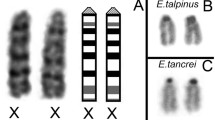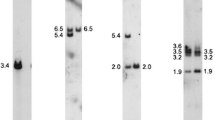Abstract
Ellobius lutescens carries an apparently identical karyotype (2n = 17) in both sexes. On the basis of indirect evidence the unpaired chromosome 9 has been considered to represent the X chromosome of this species. We have obtained data to substantiate this view by four different techniques. After fusion of HPRT− RAG cells with E. lutescens fibroblasts we demonstrated that the enzymes HPRT and G6PD are localized on the presumptive X chromosome. By analysis of pachytene figures after silver staining we showed by electron microscopy that the single chromosome exhibits the typical features of an X chromosome in male meiosis. Hybridization of (GATA)4 and (GACA)4 oligonucleotide probes to E. lutescens DNA revealed several distinct bands in the high molecular weight range some of which appeared to be specific for the individual but not for the sex of the animal. Hybridization in situ of the (GATA)4 probe on metaphase spreads of E. lutescens did not highlight any particular chromosome segment but showed a significant deficit of these sequences in chromosome 9. These observations are discussed with respect to their bearing on X chromosome determination. Finally it is concluded that E. lutescens should be an ideal tool for testing candidate genes assumed to be involved in primary sex determination.
Similar content being viewed by others
References
Arnemann J, Jakubiczka S, Schmitke J, Schäfer R, Epplen JT (1986) Clustered GATA repeats (Bkm sequences) on the human Y-chromosome. Hum Genet 73:301–303
Castro-Sierra E, Wolf U (1967) Replication patterns of the unpaired Chromosome 9 of the rodent Ellobius lutescens TH. Cytogenetics 6:268–275
Castro-Sierra E, Wolf U (1968) Studies on the male meiosis of Ellobius lutescens Th. Cytogenetics 7:241–248
De la Maza LM, Sawyer IR (1976) The G and Q banding pattern of Ellobius lutescens. A unique case of sex determination in mammals. Can J Genet Cytol 18:497–502
Djalali M, Hameister H, Vogel W (1986) Further chromosomal studies in Ellobius lutescens: Heteromorphism of chromosome 1 is not associated with sex determination. Experientia 42:1281–1282
Dresser ME, Moses MJ (1980) Synaptonemal complex karyotyping in spermatocytes of the Chinese hamster (Cricetulus griseus). Chromosoma 76:1–22
Epplen JT, McLaren A (1987) GACA/GATA simple repeated DNA as a means to dissect the sex-reversed (Sxr) mutation of the mouse. In: Wachtel SS (ed) Evolutionary mechanisms in sex determination. CRC Press, Boca Raton, Florida
Epplen JT, Ohno S (1987) On DNA, RNA and sex determination. In: Lau YFC (ed) Selected topics in molecular endocrinology. Oxford University Press, New York
Epplen JT, Studer R (1987) On interspersed repetitive DNA sequences in animals. In: Sharma T (ed) Advances in chromosome research, in press
Epplen JT, Cellini A, Romero S, Ohno S (1983) An attempt to approach the molecular mechanisms of primary sex determination: W- and Y-chromosomal conserved simple repetitive DNA sequences and their differential expression in mRNA. J Exp Zool 228:305–312
Howell WM, Black DA (1980) Controlled silver-staining of nucleolus organizer regions with a protective collodial developer: a 1-step method. Experientia 36:1014–1015
Maniatis T, Fritsch EF, Sambrook J (1982) Molecular cloning: a laboratory manual. Cold Spring Harbor Laboratory Press, Cold Spring Harbor, New York
Matthey R (1953) La formule chromosomique et le probleme de la determination sexuelle chez Ellobius lutescens (RodentiaMuridae-Microtinae). Arch Julius Klaus-Stift Vererbungsforsch 28:271–280
Matthey R (1958) Un nouveau type de determination chromosomique du sex chez les mammiferes Ellobius lutescens. Th et Microtus (Chilotus) Bachm (Murides-Microtines). Experientia 14:240–241
Matthey R (1964) Etudes sur les chromosomes d'Ellobius lutescens (Mammalia-Muridae-Microtinae). II. Informations complementaires sur les divisions meiotiques. Rev Suisse Zool 71:401–410
Miyada CG, Reyes AA, Studencki AB, Wallace RB (1985) Methods of oligonucleotide hybridization. Proc Natl Acad Sci USA 82:2890–2894
Moses M (1977) Synaptonemal complex karyotyping in spermatocytes of the Chinese hamster. Chromosoma 60:99–125
Nanda J, Neitzel H, Sperling K, Studer R, Epplen JT (1988) Simple repetitive GATA/GACA sequences characterize the X-chromosomal heterochromatin of Microtus agrestis, european field role (rodentia cricetidea). Chromosoma, in press
Nesbitt MN, Francke U (1973) A system of nomenclature for band patterns of mouse chromosomes. Chromosoma 41:145–158
Ohno S (1963) The creeping vole (Microtus oregoni) as a gonosomic mosaic. I. The OY/XY constitution of the male. Cytogenetics 2:232–235
Ohno S, Jainchill J, Stenius C (1964) X-autosome ratio and the behaviour pattern of individual X-chromosomes in placental mammals. Chromosoma 15:14–30
Pathak S, Hsu TC (1979) Silver stained structures in mammalian meiotic prophase. Chromosoma 70:195–203
Pontecorvo G (1976) Production of indefinitely multiplying mammalian somatic cell hybrids by polyethylene glycol (PEG) treatment. Somatic Cell Genet 1:397–400
Schäfer R, Ali S, Epplen JT (1986) The organization of the evolutionarily conserved GATA/GACA repeats in the mouse genome. Chromosoma 93:502–510
Schmid W (1967) Heterochromatin in mammals. Arch Julius Klaus-Stift Vererbungsforsch 42:1
Singh L, Jones KW (1982) Sex reversal in the mouse (Mus musculus) is caused by a recurrent nonreciprocal crossover involving the X and an aberrant Y chromosome. Cell 28:111–120
Singh L, Purdom JF, Jones KW (1981) Conserved sex-chromosome associated nucleotide sequences in eukaryotes. Cold Spring Harbor Sym Quant Biol 45:805–813
Speed RM (1986) Oocyte development in XO foetuses of man and mouse: the possible role of heterologous X-chromosome pairing in germ cell survival. Chromosoma 94:115–124
Szybalski W, Szybalski EH, Ragni C (1962) Genetic studies with human cell lines. Natl Cancer Inst Monogr 7:75–89
Tsao SGS, Brunk CF, Pearlman RE (1983) Hybridization of nucleic acids directly in agarose gels. Anal Biochem 131:365–372
Wolf M, Schempp W, Vogel W (1979) Ellobius lutescens Th (Rodentia, Microtinae): Q-, R-, and replication banding patterns. Chromosome 1 polymorphism in the male and presumptive heterogamety in the female. Cytogenet Cell Genet 23:117–123
Wolf U (1974) Cell cultures from tissue explants. In: Schwarzacher HG, Wolf U (eds) Methods in human cytogenetics. Springer, Berlin Heidelberg New York
Author information
Authors and Affiliations
Rights and permissions
About this article
Cite this article
Vogel, W., Steinbach, P., Djalali, M. et al. Chromosome 9 of Ellobius lutescens is the X chromosome. Chromosoma 96, 112–118 (1988). https://doi.org/10.1007/BF00331043
Received:
Revised:
Issue Date:
DOI: https://doi.org/10.1007/BF00331043




